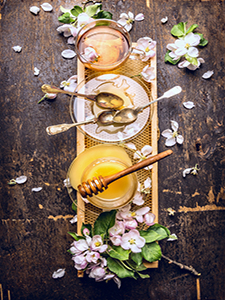A New Look At Florals For Spring

"Florals for spring? Groundbreaking."
Yes, Ms. Priestly. Go put your Prada boots back on and sip on these for a change:
Chrysanthemum
In flower language, it can mean "You're a wonderful friend," "Cheerfulness and rest," "I love," "Truth," or "Slighted love," depending on the color and context. This makes it almost a safe bet for friendly bouquets.
You'd have better luck with chrysanthemum as a tea. Chrysanthemum tea has been used for centuries for its medicinal properties, soothing away inflammation and issues that come from an overactive thyroid—a condition that affects a growing number of individuals today. Popping a cup of chrysanthemum tea, rather than an ibuprofen, can be highly useful for stress reduction, as inflammation can be a symptom that the adrenals are being taxed.
In terms of flavor, chrysanthemum's sweetness needs no prescription. On first contact, the sip comes off as a sunflowery sort of chamomile: bright and buttery in the cup. Let the familiar meadow notes play in your mouth, and heave a sigh of relief.
Rose
The hips don't lie, and neither do the petals. Just make sure it's the edible kind—some garden variety roses are not meant for consumption!
In flower language, roses symbolize everything from innocence to desire, so be careful which one is in your cup. The Tea Rose, for instance, says, "I'll remember; always." (Unless it happened in Vegas. Let it stay in Vegas.)
Medicinally, both hips and buds are charged with beneficial properties. The hips alone contain more vitamin C than a wild pack of oranges, useful for keeping that immune system in check—you don't want to be stuck with the sniffles when April showers come along. Rose petals, meanwhile, are a known light sedative and popular in skincare for the calming properties of their oils and aroma.
As a tea, rose gives you a mixed bag of flavors. Rosehips are in the red fruit family, punchy and tart as hibiscus. You'll often find them in popular grocery store tea blends as an additional ingredient. The inclusion of petals is more for fragrance than anything else. Let the hot water activate those calming oils for some home-brewed aromatherapy.
Jasmine
Before she was a Disney princess, this blossom was revered around the globe. Symbolizing love, beauty, sensuality, and purity, jasmine is also the national symbol of Pakistan, Indonesia, and the Philippines. You'll find it anywhere warm and humid—with global warming and flower nurseries, this means jasmine is everywhere.
When used as a medicine, jasmine flowers act similarly to rose petals, inducing calm and a sense of balance. The taste and aroma impart a mild euphoria, gently lifting you through the next few hours of your day. This sensation lends it well to South Asian religious ceremonies, particularly purification rituals.
Flavor-wise, you'll find that it rounds off our triad of chrysanthemum and rose. The aftertaste is savory enough to be vegetal, while the aroma on its own is all the way on the floral end of the scale. You'll find it often added to softer true teas, like greens and whites, to bring forth a new dimension of flavor. For instance, if you meander down any tea aisle in Chinatown, there will be a blend of jasmine and Pi Luo Chun.
Jasmine is also popular as a "flowering" tea. Just pop it in your favorite glassware and watch the show. You may be tempted to let it sit there until it oversteeps—but at least it makes for a pretty picture!
Cheers.
Reference:
http://thelanguageofflowers.com/
